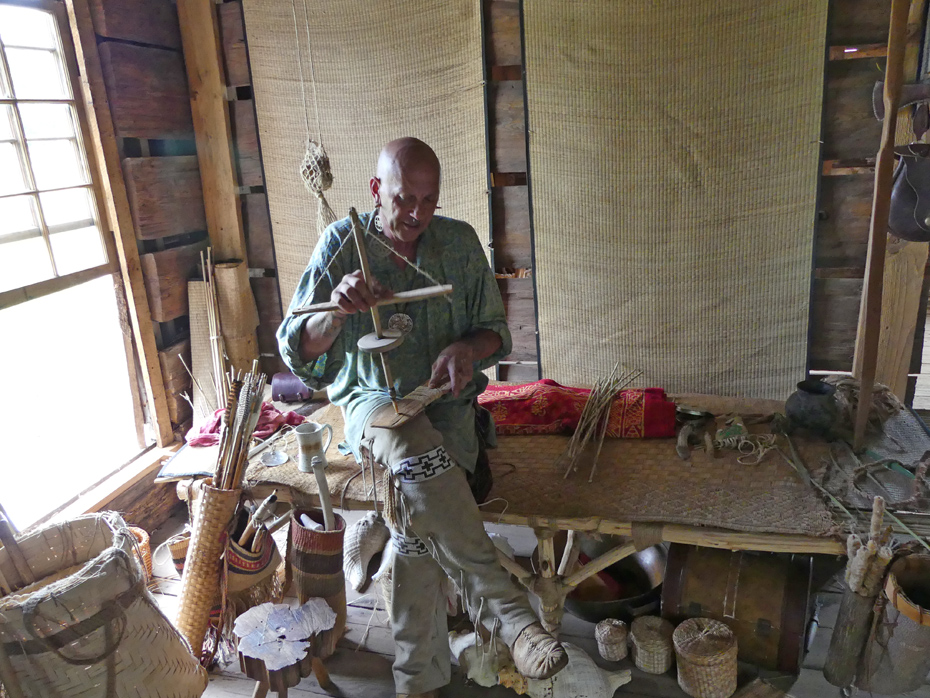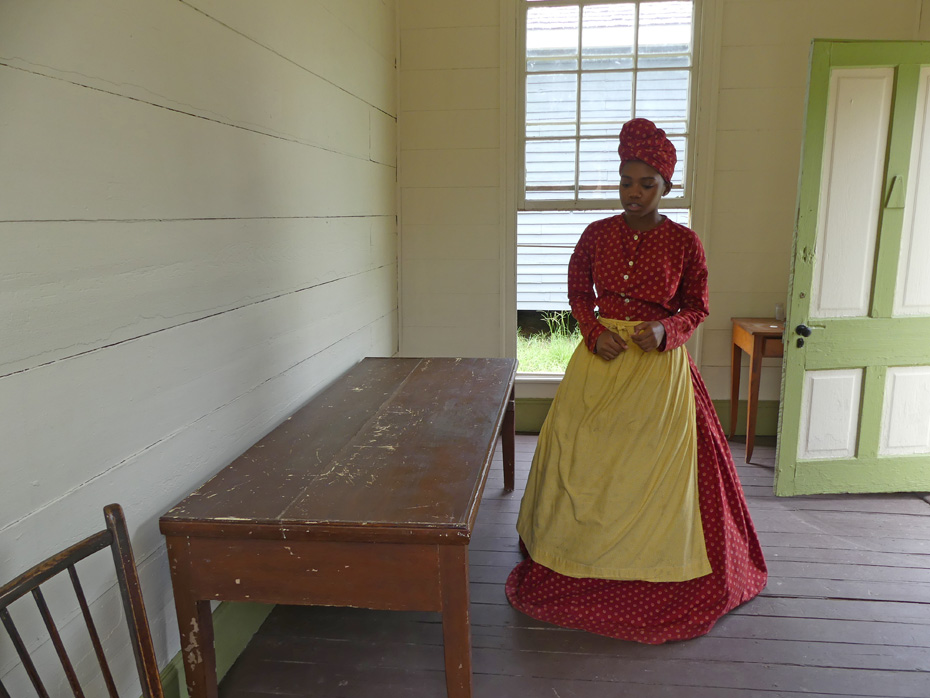
|
|
|
|
|
|
|
|
|
|
Long awaited Westville, a living history recreation of a typical Georgia town in the 1800s is now alive and in full swing again in Columbus, Georgia. Its authentic homes and building have been moved from around the state. It had begun in Lumpkin and was closed down for a good while to complete the move. I visited there this month and was transported back to the old days. I recently told of the move and way back told of the original Westville, so today I'll introduce you to some of the residents.
The shoemaker, Timothy at Johann Singer's Boots and Shoes Shop, was busy making boots. When we entered we saw he also made saddles. He took time to gossip with us about the Singers. "Johann Singer was the first boot maker in the area. When the Singers first moved here, the shop was in the house. That's why it has two front doors. One was the boot shop and the other was the family entrance. He became very popular. In just over a year he built the house in 1837 and he built the shop in 1838."
Next door at the Singer house, we met Sarah. She was quilting but took time away from her work to show how to do carding of the wool. She was so knowledgeable about the trends of this time. She explained why the strange mix of patterns in clothes in that era. "They were just discovering the mass production of fabrics so you didn't have to weave them at home. They were going a little color crazy." Which explained some of the bright colors the rooms in well-to-do homes were painted.
The family had 11 children so usually the youngest slept on a trundle bed in the master bed room. The crib in that room is original to the Singer's home. The girls slept in the other bedroom and the boys slept in the attic over the shop. She showed us through the house and showed us many of the Singer family treasures, like an embossed metal chest and a gold colored tea pot with brightly colored hand painting.
The housekeeper at McDonald House, Jacque, was busy hand stitching an authentic looking blue and white checked apron in the parlor. She explained that this was what the ladies in the family would often do, either sewing or embroidering.
She told us a bit of the history of the McDonald family as she led us through the home which was built in 1843. The home started with just the two back rooms. Mr. McDonald became rich from the profits of a cotton warehouse he started and then when the trains came through in 1859 that farther improved his finances. He added on the ladies and men's parlor and the upstairs rooms. He had 24 enslaved people.
Native American people lived in the area and often mingled with the white settlers before Andrew Jackson's illegal Indian Removal Act of 1826 forced their resettlement in Oklahoma. The Creek people had been there for thousands of years before these new settlers arrived. We met one of them, Jeremy, in the Yuchi House/ Wells House.
This house is the oldest in the village and the Wells family, who remained in ownership for over 100 years, left oral and written records that the original structure, a log pen cabin and a shed with a dirt floor, had been built and lived in by Yuchi Indians, somewhat related to the Creek Nation.
When we arrived Jeremy was working on his outdoor kitchen. He had built it by stripping the logs and sinking four posts in the ground then mounting two supports between them to support a cast iron pot. He was one of the most amazing docents; he told us he was one of only two Creek people here. He actually showed us how to drill a hole with a small handmade wood tool with a small four point flint point on the drilling end. He worked it with just a small string to spin the main stick.
He showed us a traditional fire starter his people had used but said after the settlers came his people liked the flint the white men used. He demonstrated starting a fire with a flint and some rope fibers within a minute.
Blacksmithing was one of the most important trades of the time. Cameron was making a tool to chop herbs when we stopped in at the blacksmith shop. He was hammering to pound out a sharp point on a red hot piece of iron. He was proud of his state-of -the-art large overhead pump and told us when he first started he had just a hand pump and had to keep pumping all the time. His fire was glowing hot with just one pull of the rope that operated this pump. He told us the average blacksmith's salary was about $1 a day which would have been about $40 a day in today's money.
Dressmaker, Chelsea, greeted us at Adams Clothier and Fine Fashions Shop. The shop showcased the fashions from 1840 to 1860. Chelsea is the real life dressmaker for most of the village clothes. In that era, ladies would pick an image from a magazine, then the dressmaker would measure them and sketch the pattern on paper and make the dress with a combination of sewing machine work and hand stitching. Cotton, wool, flax and silk were the materials of the day.
A doctor was a very important person in any small town. We met medical assistant, Lena, at Dr. William Paullin's office. The office was built in 1845 and he used it until his death in 1880 however he frequently made house calls. Lena showed us how the doctor would make his prescription pills from herbs he grew in the backyard. She showed us many of the instruments he used. One especially was a valuable surgical kit dated back to the 1800s. He had been a surgeon in the Civil War. There is a chart of some of the old remedies he used; like blackberry roots for dysentery or willow bark for fever. This is like stepping back in time. So do some time travel and meet some fascinating folks who lived and died long before you were born. They love to tell you about their way of life in Westville. For more info: https://westville.org/
We'd love your comments!
|
Connect with us on:
American Roads
and | ||
|
Public Disclosure--
Please Read The FTC has a law requiring web sites to let their readers know if any of the stories are "sponsored" or compensated. We also are to let readers know if any of our links are ads. Most are not. They are just a way to direct you to more information about the article where the link is placed. We also have several ads on our pages. They are clearly marked as ads. I think readers are smart enough to know an ad when they see one but to obey the letter of the law, I am putting this statement here to make sure everyone understands. American Roads and Global Highways may contain affiliate links or ads. Further, as their bios show, most of the feature writers are professional travel writers. As such we are frequently invited on press trips, also called fam trips. On these trips most of our lodging, dining, admissions fees and often plane fare are covered by the city or firm hosting the trip. It is an opportunity to visit places we might not otherwise be able to visit. However, no one tells us what to write about those places. All opinions are 100% those of the author of that feature column. . |
|||
|
Privacy Policy/ Archives /
Contributors /
Subscribe to
American Roads Books by
Kathleen Walls /
Contact /
Sponsor or Advertise/ American Roads & Global Highways Home Page
|



















